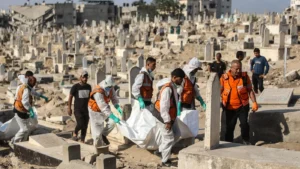Gaza cannot heal while its dead go unnamed

Civil defence workers & relatives carry remains of the Shahebar family for burial at Sheikh Shaaban Cemetery in Gaza City on 24 October 2025, after around 80 family members were killed in an Israeli air strike on the Sabra neighbourhood in November 2023
Sara El Khatib writes in Middle East Eye on 17 November 2025:
After more than two years of Israel’s genocidal war on Gaza, a fragile ceasefire was announced on 9 October 2025.
Despite Israel’s continued violations, the brief pauses in bombardment have allowed Palestinians to start limited recovery efforts and hold long-overdue discussions on what must follow beyond emergency relief.
Within the first week of the ceasefire, 436 bodies were retrieved from under the rubble by Gaza’s Civil Defence teams, and 195 bodies were returned by Israel, of which only 57 were identified. With no functioning forensic equipment, many will be buried unnamed, leaving families trapped in uncertainty and suspended grief.
At first glance, this might appear to be a logistical issue, but the challenge has revealed a deeper moral and psychological crisis. The destruction of Gaza’s forensic capacity means the estimated 10,000 bodies still trapped beneath the rubble may never be identified or properly counted.
International teams have entered Gaza to search for the remains of Israeli captives, yet no comparable urgency exists to recover or identify Palestinian victims.
New MEE newsletter: Jerusalem Dispatch
Sign up to get the latest insights and analysis on Israel-Palestine, alongside Turkey Unpacked and other MEE newsletters
This disparity exposes a moral imbalance – one that determines whose lives are treated as worthy of recognition and whose are forgotten. It also raises urgent questions about how this process, or its neglect, will shape memory and the possibility of healing for future generations.
The inability to name and bury loved ones denies both closure and dignity. It transforms mourning into an unending process, passing grief and silence from one generation to the next. The absence of identification capacity in Gaza will not only obstruct justice but also erode the foundations of personal and collective healing for Palestinians.
Naming the dead
In previous examples of post-genocide recovery, the process of identifying the dead has proved essential for healing and long-term reconciliation.
In Bosnia and Herzegovina, the remains of Bosniak victims continue to be unearthed and identified each year to be buried during the annual commemoration in Srebrenica in July.
Nearly 30 years after the Srebrenica genocide, hundreds of bodies remain missing. Their absence continues to impede healing for families and communities.
